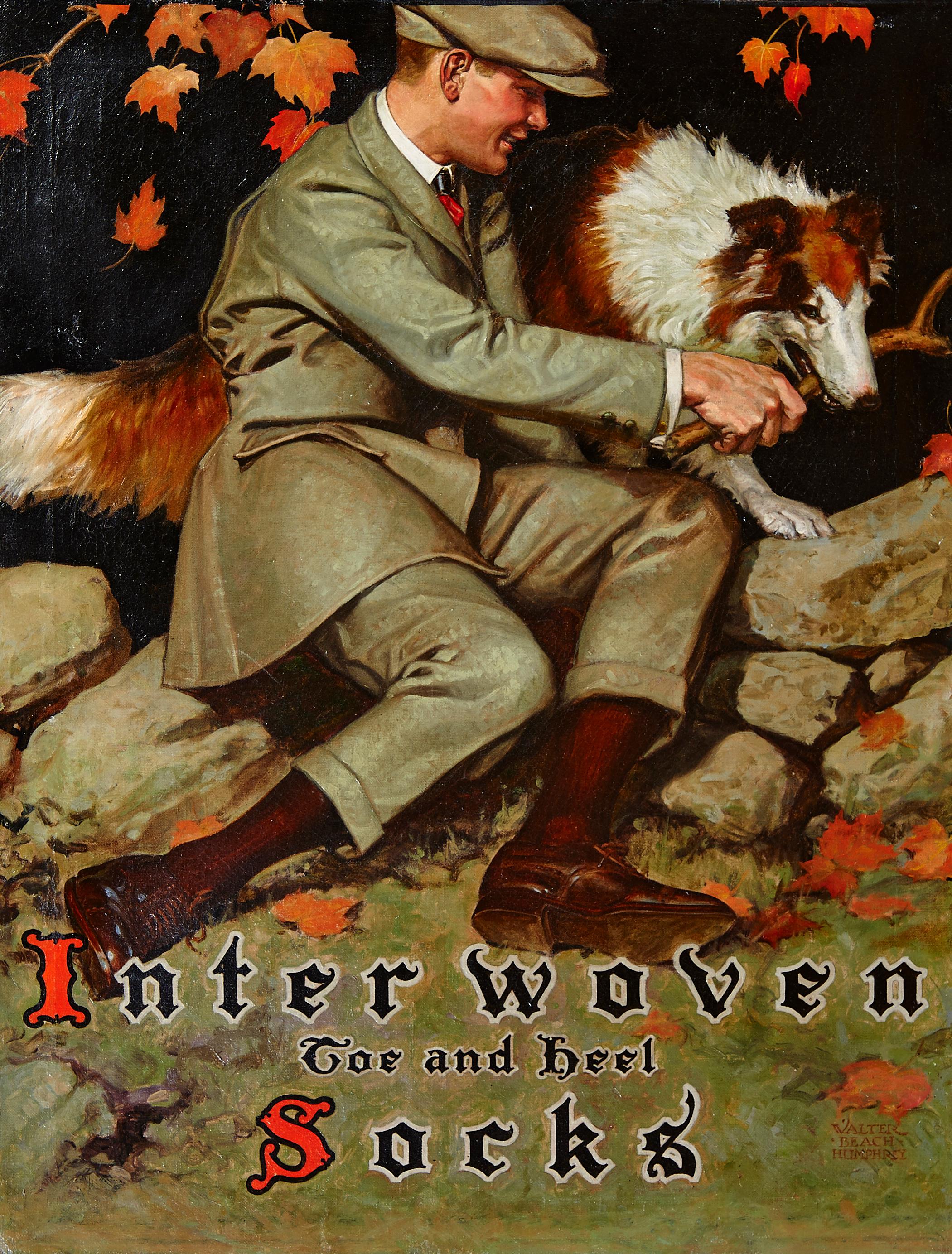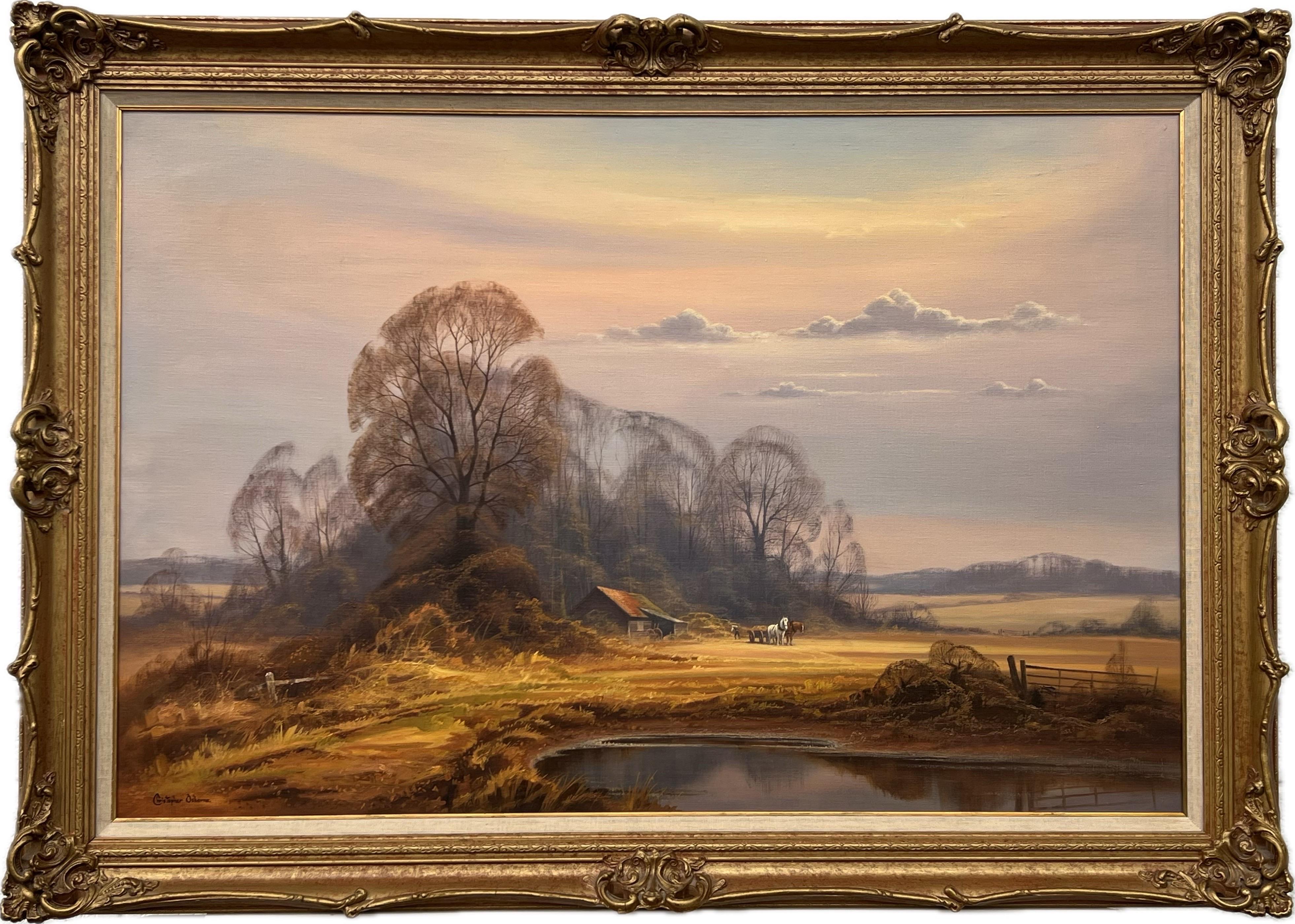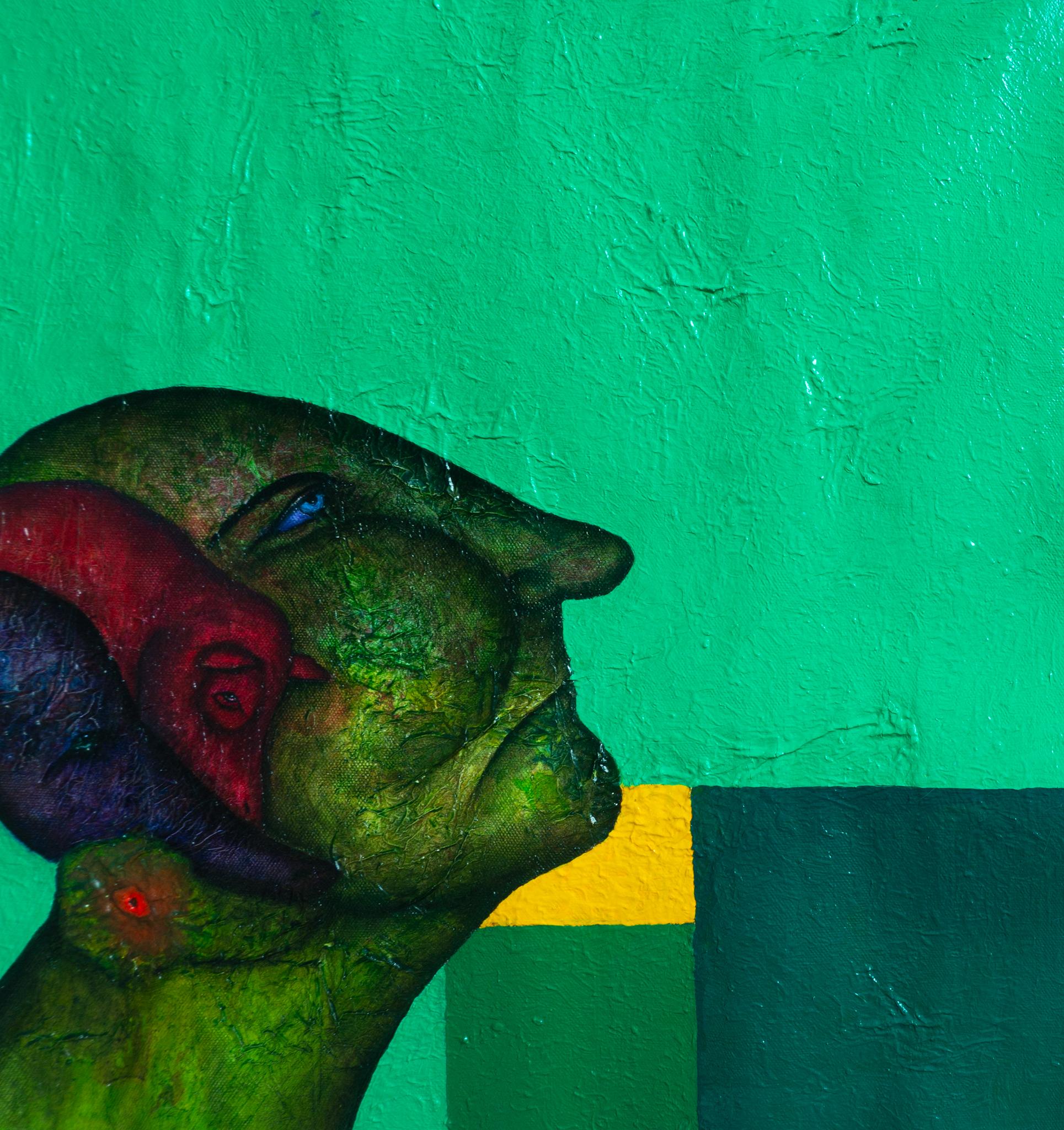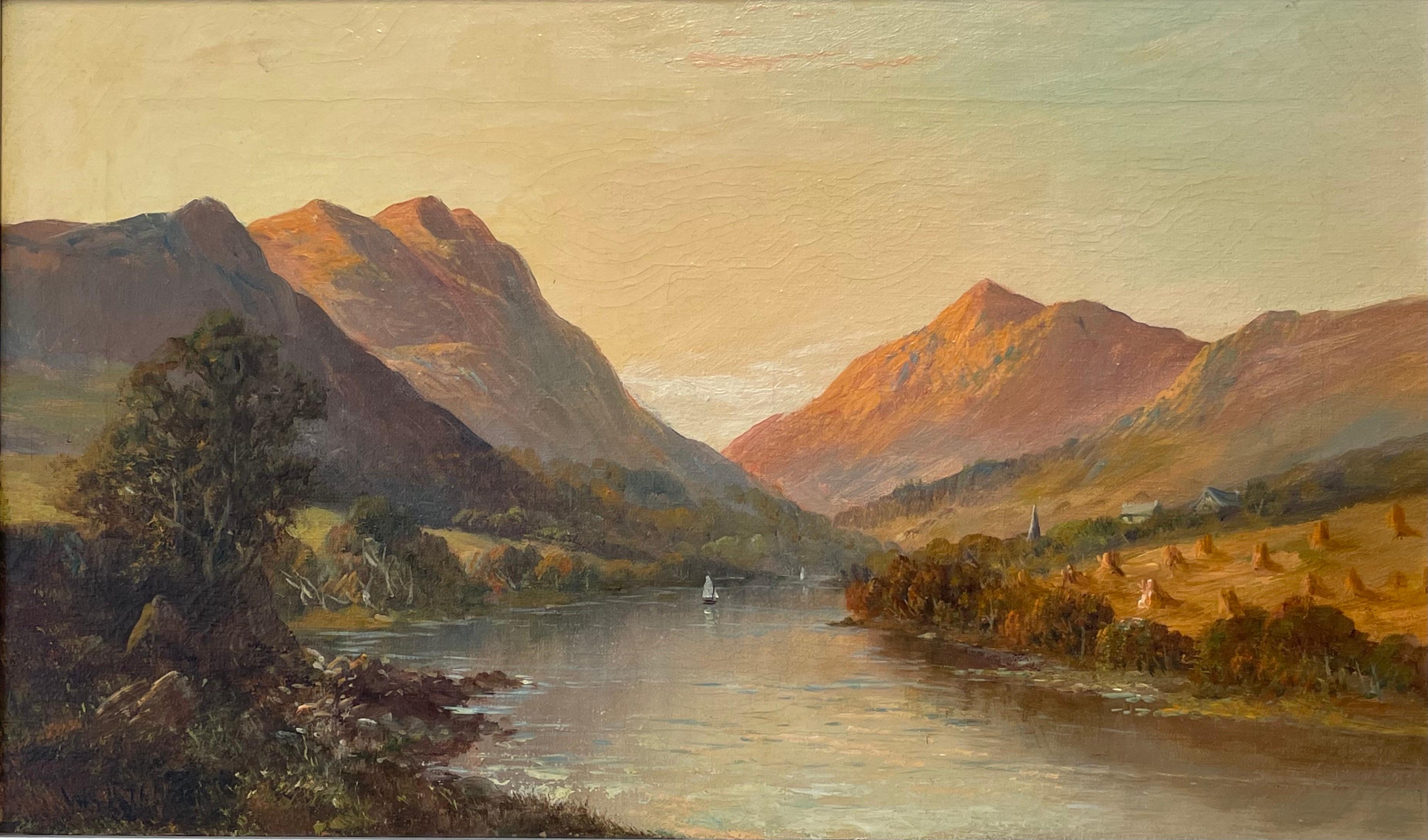Items Similar to Grazing Horse
Want more images or videos?
Request additional images or videos from the seller
1 of 10
Ruggero Panerai (Firenze 1862-1923)Grazing HorseLast quarter 19th century
Last quarter 19th century
About the Item
Ruggero Panerai (Firenze 1862-1923)
Grazing horse
Oil on canvas in gilded frame
Canvas size 100x70 cm (116x86 cm with frame)
Signed at the bottom left
Last quarter 19th century
Ruggero Panerai was born in Florence on 13 March 1862. He was employed as a carpenter until the age of fifteen and then studied at the Academy of Fine Arts in Florence, which he attended from 1877 to 1881. His teacher was Giovanni Fattori, who introduced him to the naturalistic painting of landscapes of the Tuscan Maremma and considered him among his most deserving students.
Factors' teachings were decisive in orienting the young artist, who adopted the themes and the pictorial technique, updating them with the naturalism flowered in Tuscany through the example of Luigi and Francesco Gioli, Tommasi and Egisto Ferroni.
In 1883 he exhibited at the Promotrice in Florence, his impressionism was inspired by the works of Guido Carocci. His painting is also affected by the bourgeois and worldly look of Giuseppe De Nittis and the manner of Vittorio Matteo Corcos who for some years lived in Paris but who returned to Livorno from time to time. Useful for a contact with the Parisian culture could also have been, for Panerai, the proximity with Francesco and Luigi Gioli, who in 1878 went to the French capital, where they had frequented Federico Zandomeneghi.
Panerai was also attracted by the military theme. Military subjects are in fact among the most practiced and loved by the artist, who declines them in numerous variations, mostly devoid of pathos, but adhering to a quiet image.
In 1887 his painting "Il Guado", presented in Venice, was chosen for the National Gallery of Modern and Contemporary Art in Rome, but instead entered the "Pisani" Gallery. In the same year he exhibited in Genoa, Florence and Milan, where he won the Fumagalli Prize with "Il cavallo malato" (Florence, Galleria d'arte moderna of Palazzo Pitti), a painting in which his qualities as a sensitive animalist painter stand out, making with finesse the atmosphere full of doubts that emanates from the two herdsmen bent over the crouching horse, immersed in the natural scenery of an unspoilt Maremma.
He was appointed professor of the Academy of Fine Arts in Bologna. Around the nineties, in a more delicate chromatism, he still portrayed subjects of nineteenth-century Florence and later painted genre scenes. In later times Panerai also dealt with mythological subjects. A collection of his drawings was donated by his widow Henrietta to the Uffizi Office. He died in Paris on 24 October 1923.
All works sold by us are accompanied by a certificate of authenticity and analytical study of the work.
We ship the painting in a solid wooden case made to measure
The time required to prepare a wooden crate is approximately 7 days
We remain at your disposal for any further information.
- Creator:Ruggero Panerai (Firenze 1862-1923) (1862 - 1923, Italian)
- Creation Year:Last quarter 19th century
- Dimensions:Height: 45.67 in (116 cm)Width: 33.86 in (86 cm)
- Medium:
- Period:
- Condition:Original frame, original canvas, without restoration, just a light cleaning of the surface.
- Gallery Location:Como, IT
- Reference Number:1stDibs: LU2536212336872
About the Seller
5.0
Vetted Seller
These experienced sellers undergo a comprehensive evaluation by our team of in-house experts.
Established in 1993
1stDibs seller since 2023
- ShippingRetrieving quote...Ships From: Como, Italy
- Return PolicyA return for this item may be initiated within 14 days of delivery.
More From This SellerView All
- The Holy Family with Saint John the BaptistLocated in Como, ITCircle of Bernardo Castello (1557-1629) The Holy Family with Saint John the Baptist 1600-1615 circa Oil on canvas in gilded frame Measures in cm: 84 x 63 cm (104 x 84 cm including frame) Measures in inch: 33.07 x 24.80 in (40,95 x 33,08 in including the frame) One of the most widespread iconographies in Italian painting from the Renaissance onwards, that of the Holy Family, is set in a sober and at the same time elegant interior, as the presence of the gold-edged green curtain that closes the space like a backdrop states. Whether it takes place in the intimacy of the house in Nazareth, as in the painting presented here, or it is placed outdoors, the scene includes the presence in the role of protagonists of the Madonna and Child Jesus, flanked by the protective figure of Joseph, always held a slightly aloof. In some cases, including ours, the Child is in dialogue with the little John the Baptist, thus alluding to the role played by the latter in the history of salvation, as the gesture of Jesus explicitly indicates in our canvas, who blesses the one who will be destined to baptize him in the waters of the Jordan. The 'room' dimensions, the calm religious intonation that pervades the representation, underlined by the very evident presence of the haloes, attest that the painting was conceived for the private devotion of its client and probably intended for a bedroom or for the walls of a small home chapel. The cleaning carried out in recent times allows you to appreciate the bright and lively chromatic range, orchestrated on the refined harmony between the shades of the Virgin's robes - blue and carmine red - and the bright green of the curtain that forms the backdrop to the scene. A particularly delicate pictorial drafting, well appreciated in the soft rendering of the faces and limbs of the two children - observe, for example, the suffused chiaroscuro transitions of the face of Jesus - is combined with a sensitive and tender description of the 'affects', allowing us to place this painting in the context of the painting of the Catholic Counter-Reformation and of the principles of verisimilitude and naturalness advocated by it in reaction to the expressive licenses and formal abstractions of the Mannerist figurative culture derived from Michelangelo's lesson. The return to a sober and juxtaposed pictorial language and simplified compositional schemes, often inspired by the early sixteenth century examples of Raphael and Andrea del Sarto, which we also recognize in our Holy Family, characterizes the work of numerous artists scattered throughout the various centers of the Peninsula , from the Bologna of the Carracci, to the Tuscany of Santi di Tito, to the Marche of Federico Barocci, up to Rome, Naples and Milan, where Camillo Procaccini and Guglielmo Caccia...Category
Early 17th Century Figurative Paintings
MaterialsCanvas, Oil
- Portrait of a MusketeerLocated in Como, ITTITO CONTI (Florence 1842 - 1924) Portrait of a Musketeer Oil on canvas in gilded frame Signed in the upper right Canvas measures 40x30 cm (51x43 cm includ...Category
19th Century Figurative Paintings
MaterialsCanvas, Oil
- Saint Francis of Assisi comforted by an angelLocated in Como, ITGuglielmo Caccia said the Moncalvo (Montabone, 1568 - Moncalvo, 1625) Saint Francis of Assisi comforted by an angel Oil on canvas, cm 96 x 73 - (wi...Category
Early 17th Century Old Masters Figurative Paintings
MaterialsCanvas, Oil
- Portrait of a ButteroLocated in Como, ITTITO CONTI (Florence 1842 - 1924) Portrait of a Buttero Oil on canvas in gilded frame Signed in the upper right Canvas measures 40x30 cm (51x43 cm includin...Category
19th Century Figurative Paintings
MaterialsCanvas, Oil
- Ettore Cosomati (1871-1960) Still life of Marigolds with lemons and pipeLocated in Como, ITEttore Cosomati (Naples 1871 - Milan 1960) Still life of Marigolds with lemons and pipe Oil on canvas in gilded frame Size: 53 x 45 cm (73 x 64 cm including frame) Epoch: the paint...Category
Early 20th Century Still-life Paintings
MaterialsCanvas, Oil
- Ligurian pine forestLocated in Como, ITHenry Markò (Florence 1855-1921) Ligurian pine forest Oil on canvas in gilded frame First quarter 20th century Signed to the lower left Size: 74x104 cm (92x121 cm including frame) Henry Markò, born in Florence, is a landscape and seascape painter of remarkable sensitivity, undoubtedly linked to the late 19th-century painting tradition with hints of Romanticism. A descendant of the painting dynasty headed by the Austrian Andrea Markò, he painted a series of works between the nineteenth and twentieth centuries that were characterized by skillful scenic layout: rare seascapes of the Ligurian Riviera, luminous and highly detailed in execution, numerous wooded landscapes, sometimes enlivened by figurines, and frequent views of cities such as Florence, Rome, Genoa, and Sestri Levante...Category
Early 20th Century Landscape Paintings
MaterialsCanvas, Oil
You May Also Like
- Interwoven Socks AdvertisementBy Walter Beach HumphreyLocated in Fort Washington, PAApproximate Date: 1920-1925 Medium: Oil on Canvas Signature: Signed Lower Right Size: 29.50" x 23.00" Interwoven Socks Advertisement Literatu...Category
1920s American Modern Animal Paintings
MaterialsCanvas, Oil
- Tiger & Fighter PlaneBy Roy GrinnellLocated in Fort Washington, PASigned Lower LeftCategory
20th Century Animal Paintings
MaterialsOil, Canvas
- Baddie (coyote, man, wild animal, americana, surrealist painting, nature, field)By Rudolf KosowLocated in Quebec, QuebecThis surrealistic painting on canvas titled "Baddie" by Rudolf Kosow is an enthralling visual narrative that masterfully weaves together three essential elements: man, animal, and na...Category
2010s Surrealist Animal Paintings
MaterialsCanvas, Oil
- Traditional English Farm with Horses, Figures, Trees & Lake by British ArtistLocated in Preston, GBEnglish Farmhouse with Horses, Figures, Fields, Trees & Lake entitled 'Winters Morn' by 20th Century British Artist. Art measures 36 x 24 inches Frame measures 41 x 30 inches Ch...Category
Late 20th Century Photorealist Landscape Paintings
MaterialsCanvas, Oil
- Portrait in green with beings of lightLocated in Bogotá, BogotáOil painting on canvas, measuring approximately 14.5 inches by 14.5 inches. It features a human silhouette with green textures and two fantastical animals, against a background of gr...Category
2010s Contemporary Portrait Paintings
MaterialsCotton Canvas, Oil
- Antique Scottish Highlands Signed Oil Painting Summer Loch Sunset Harvest FieldBy Francis E. JamiesonLocated in Cirencester, Gloucestershire"Aberfeldy" by F. E. Jamieson (British 1895-1950) signed, lower corner with pseudonym "W. Richards" titled verso to canvas oil painting on canvas, framed canvas: 12 x 20 inches fra...Category
Early 20th Century Victorian Landscape Paintings
MaterialsOil, Canvas
Recently Viewed
View AllMore Ways To Browse
Luigi Gioli
Panerai Left
Bob Kuhn
Focal Watch Retro
Mackenzie Childs Circus
Taylor Kent China
Tony Pridham
Vintage Cowboy Boots Size 5
Vintage Hiawatha
Casey Baugh
Dtr Modern Galleries Hunt Slonem
Dtr Modern Galleries Slonem
Edmund Osthaus Edmund
En Welch
Horseshoe Calendar
John Frederick Herring Sr. On Sale
Lise Lang Crowley On Sale
Natchez Mississippi





